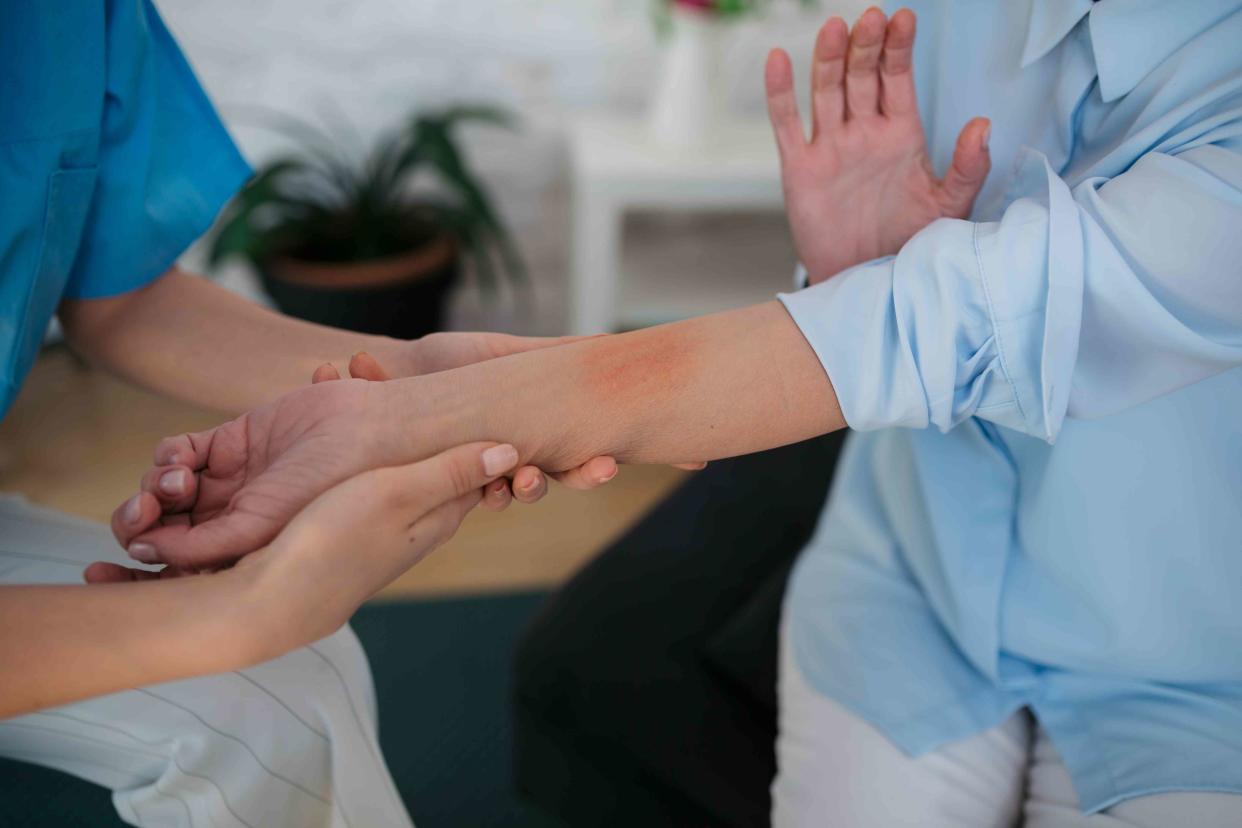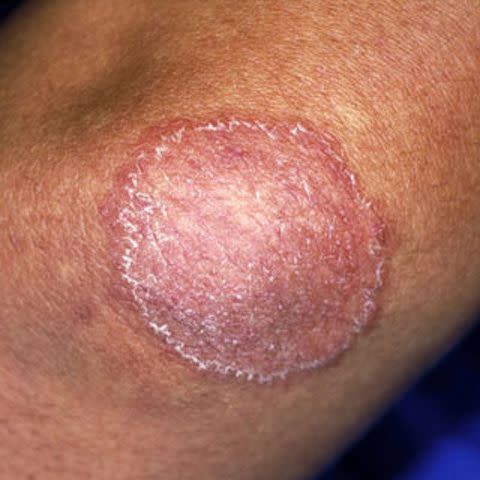How Do You Get Ringworm?

Brothers91 / Getty Images
Medically reviewed by Susan Bard, MD
Ringworm is a contagious fungal infection that affects the outermost layer of your skin—known as the epidermis—and causes a circular or ring-like rash. The rash commonly causes redness, scales, and itchiness. The fungi that cause ringworm are called dermatophytes, which are a type of parasite that live off of the keratin (a type of protein) in your skin, nails, and hair.
The ringworm infection usually does not go past the epidermis in people with a healthy immune system because their immune system can fight off the fungi. As the fungi begin to multiply and grow, your immune system will begin to attack the fungi. As a result of this immune response, the site of the infection can become inflamed as the tissue on your skin starts to break down. Several factors can increase your risk of ringworm, such as your environment and contact with others.
How Ringworm Spreads
Ringworm can spread very easily. You can transmit the infection to others or contract the infection yourself in the following three ways:
Person-to-person: You can get a ringworm infection from someone who has the infection. You might develop the infection by touching the skin of an infected person directly or sharing personal items, such as towels or clothing.
Animal-to-person: If your pet or other animal has a ringworm infection or fungi on their fur and you come into contact with the animal, you might also develop the condition. Many different kinds of animals can spread ringworm, including household pets, such as puppies and kittens.
The environment: The fungus that causes ringworm can live in soil and on moist surfaces and rooms, such as the locker room at your gym or an indoor swimming pool. Transmission of the fungi can happen when you touch these contaminated surfaces, which can increase your risk of contracting the infection.
If you contract ringworm, your rash can look similar to the image below.

Courtesy of Dermnet
Is Ringworm Hereditary?
There is some research that shows that you may be more vulnerable to contracting ringworm due to your genetics. One study theorizes that there is a problem in the innate and adaptive immunity process for some people. Innate immunity is how your body naturally responds to harmful pathogens (like fungi), while adaptive immunity is how your body responds to pathogens after you've been exposed to harmful cells.
Essentially, this theory suggests that certain genes can interrupt your immune system's ability to fight off infections. Specifically, people with low defensin beta 4—a gene that is involved in the innate immune response—may be more likely to develop skin infections caused by dermatophytes, such as ringworm.
Who's at Risk?
Ringworm infections are common and can affect anyone worldwide. Research estimates that 10% to 15% of people will develop the infection or come into contact with the fungi at some point in their lifetime. But, some people are more at risk of developing the infection than others, based on factors such as:
Geographic region: Tropical regions are the most suitable environment for this infection to spread. The fungi that cause the ringworm infection like to live in hot and humid climates. Fungal infections like ringworm tend to be more common in the tropical areas of South America, Africa, and the Pacific Islands.
Age: Infection is rare in infants. But, ringworm is common in children after they start puberty and before the age of 15. Ringworm of the scalp, known as tinea capitis, is common in children worldwide. Ringworm transmission tends to be higher in children because of poor personal hygiene and being in close contact with other young people, such as schoolmates and siblings.
Sex: People assigned male at birth appear to have a higher prevalence of ringworm. Males also tend to develop ringworm more often in their nails and feet.
Living conditions and access to care: People who live in overcrowded housing conditions, have a lack of access to clean water and proper hygiene practices, and receive limited resources to adequate healthcare may also be at an increased risk of developing ringworm.
Other Risk Factors
A variety of additional risk factors may also boost your chances of developing the infection. These factors include:
Being immunocompromised: Living with an underlying health condition, such as diabetes, cancer, or HIV/AIDS can affect your immunity. As a result, you may be more susceptible (or, at an increased risk) of developing ringworm.
Excessive sweating: If you sweat more than the average person or have hyperhidrosis (a condition that causes excess sweating, even if you're not hot or working out) can make it easier for fungi to breed on the moist areas of your body.
Lifestyle practices: Using public showers, wearing tight clothing, engaging in contact sports, coming into close contact with wild animals, or being in proximity to someone with the infection can make you more vulnerable to ringworm infections.
Trauma to the skin: Your skin is a natural barrier to your body and provides protection from harmful cells. If your skin becomes damaged due to some type of trauma (such as cuts, burns, or bleeding), it's easier for fungi to enter your body and cause an infection.
A Quick Review
You can develop ringworm when fungi enter your outermost skin layer and cause an infection that produces a red, circular, and itchy rash. This infection is highly contagious and may spread from person to person, animal to person, and environment to person. Risk factors like having other health conditions, living in tropical climates, and your daily activities might make you more likely to develop an active infection from the fungi.
For more Health.com news, make sure to sign up for our newsletter!
Read the original article on Health.com.

